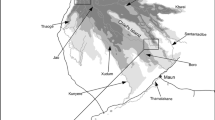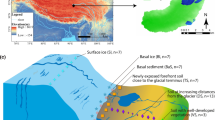Abstract
Understanding the factors determining the size and extent of Si cycling in wetlands is important, as more and more research shows they interact strongly within riverine Si fluxes. One key factor is the size of the ecosystem Si reservoir, which strongly depends on the occurrence of organisms specialized in biological Si processing. Our study was aimed to test whether tussocks, a common growth form of sedges, can efficiently retain biogenic silica. As such, they take advantage of efficient recycling of a private Si stock, providing them with a competitive advantage. We showed that tussock development caused a patch-like distribution of biogenic silica (BSi) in wetlands. While in a managed wetland (where tussocks are absent) BSi was uniformly distributed over surface layers, tussock development in an unmanaged wetland strongly interfered with BSi distribution. A mosaic of BSi richer inter-tussock soils and BSi poorer soils under tussocks developed, resulting from the active uplift of Si into the tussock from soil below the tussocks. Tussocks affected the role of wetlands as silica hot-spots and biogenic Si sinks near rivers. This implies that future studies should focus on quantifying the effect of tussock development, and human management, on system scale BSi storage.





Similar content being viewed by others
References
Aerts R, Chapin III FS (2000) The mineral nutrition of wild plants revisited: A re-evaluation of processes and patterns. Advances in Ecological Research. pp. 1–67
Banaszuk A (1994) Grasslands and meadow management in the Biebrza valley. In: Okruszko H, Wassen MJ (eds), Towards protection and sustainable use of the Biebrza Wetlands: Exchange and integration of research results for the benefit of a Polish - Dutch Joint Research Plan. pp. 287–313
Canty A, Ripley B (2011) boot: Bootstrap R (S-Plus) functions. R package version 1.3-3.,
Chapin FS III, van Cleve K, Chapin MC (1979) Soil temperature and nutrient cycling in the tussock growth form of Eriophorum vaginatum. J Ecol 67:169–189
Cloern JE (2001) Our evolving conceptual model of the coastal eutrophication problem. Mar Ecol Prog Ser 210:223–253
Conley DJ (2002) Terrestrial ecosystems and the global biogeochemical silica cycle. Global Biogeochem Cycles 16:GB1121
Conley DJ, Schelske CL (2001) Biogenic silica. In: Smol JP, Birks HJB, Last WM (eds) Tracking environmental change using lake sediments, vol 3, Terrestrial, algal, and siliceous indicators. Kluwer Academic Press, Dordrecht, NL, pp 281–293
Corenblit D, Steiger J, Gurnell AM, Naiman RJ (2009) Plants intertwine fluvial landform dynamics with ecological succession and natural selection: a niche construction perspective for riparian systems. Global Ecol Biogergr 18:507–520
Costello DF (1936) Tussock meadows in Southeastern Wisconsin. Bot Gaz 97:610–648
Crain CM, Bertness ND (2005) Community impacts of a tussock sedge: is ecosystem engineering important in benign habitats? Ecology 86:2695–2704
De Doncker L (2009) A fundamental study on exchange processes in river ecosystems. Dissertation, Ghent University, Ghent
Development Core Team R (2009) R: a language and environment for statistical computing. R Foundation for Statistical Computing, Vienna, Austria
Diemer M, Oetiker K, Billeter R (2001) Abandonment alters community composition and canopy structure of Swiss calcareous fens. Appl Veg Sci 4:237–246
Eleuterius LN, Lanning FC (1987) Silica in relation to leaf decomposition of Juncus roemerianus. J Coast Res 3:531–534
Eppinga MB, de Ruiter PC, Wassen MJ, Rietkerk M (2009) Nutrients and hydrology indicate the driving mechanisms of peatland surface patterning. Am Nat 173:803–818
Epstein E (2001) Silicon in plants: facts vs concepts. In: Datnoff LE, Snyder GH, Korndörfer GH (eds) Silicon in agriculture. Elsevier Science, Amsterdam
Fossati J, Patou G (1989) Vegetation dynamics in the fens of chautagne (Savoie, France) after the cessation of mowing. Vegetatio 85:71–81
Garbuzov M, Reidinger S, Hartley SE (2011) Interactive effects of plant-available soil silicon and herbivory on competition between two grass species. Ann Bot 108:1355–1363
Grootjans AB, van Wirdum G, Kemmers R, van Diggelen R (1996) Ecohydrology in The Netherlands: principles of an application-driven interdiscipline. Acta Bot Neerlandica 45:491–516
Grootjans AP, Bakker JP, Jansen AJM, Kemmers RH (2002) Restoration of brook valley meadows in the Netherlands. Hydrobiologia 478:149–170
Hodson MJ, White PJ, Mead A, Broadley MR (2005) Phylogenetic variation in the silicon composition of plants. Ann Bot 96:1027–1046
Hothorn T, Bretz F, Westfall P (2008) Simultaneous inference in general parametric models. Biom J 50:346–363
Houba VJG, van der Lee JJ, Novazamsky I, Walinga I (1989) Soil and plant analysis, a series of syllabi. Soil Analysis Procedures, 5. Agricultural University, Wageningen
Jacobs S, Struyf E, Maris T, Meire P (2008) Spatiotemporal aspects of silica buffering in restored tidal marshes. Estuarine Coastal Shelf Sci 80:42–52
Jonasson S, Chapin FS III (1991) Seasonal uptake and allocation of phosphorus in eriophorum vaginatum L measured by labeling with P-32. New Phytol 118:349–357
Laruelle GG, Roubeix V, Sferratore A, Brodherr B, Ciuffa D, Conley DJ, Dürr HH, Garnier J, Lancelot C, Le Thi PQ, Meunier J-D, Meybeck M, Michalopoulos P, Moriceau B, Ní Longphuirt S, Loucaides S, Papush L, Presti M, Ragueneau O, Regnier P, Saccone L, Slomp CP, Spiteri C, Van Cappellen P (2009) Anthropogenic perturbations of the silicon cycle at the global scale: Key role of the land-ocean transition. Global Biogeochem Cycles 23:17
Ma J, Miyake Y, Takahashi E (2001) Silicon as a beneficial element for crop plants. In: Datnoff L, Snyder G, Korndörfer G (eds) Silicon in agriculture. Elsevier, Amsterdam, pp 17–39
Massey FP, Ennos AR, Hartley SE (2007) Grasses and the resource availability hypothesis: the importance of silica-based defences. J Ecol 95:414–424
McLaren JR, Turkington R (2010) Ecosystem properties determined by plant functional group identity. J Ecol 98:459–469
Mitsch WJ, Gosselink JG (2000) Wetlands, 3rd edn. Wiley, New York
Olde Venterink H (2000) Nitrogen, phosphorus and potassium flows controlling plant productivity and species richness - eutrophication and nature management in fens and meadows. Dissertation, Utrecht University, Utrecht
Olde Venterink H, Kardel I, Kotowski W, Peeters W, Wassen MJ (2009) Long-term effects of drainage and hay-removal on nutrient dynamics and limitation in the Biebrza mires, Poland. Biogeochemistry 93:235–252
Peach M, Zedler JB (2006) How tussocks structure sedge meadow vegetation. Wetlands 26:322–335
Pinheiro J, Bates D, DebRoy S, Sarkar D, Team tRDC (2010) nlme: Linear and Nonlinear Mixed Effects Models. R package version 3.1-97.,
Poschlod P, Bakker JP, Kahmen S (2005) Changing land use and its impact on biodiversity. Basic Appl Ecol 6:93–98
Preiss H (1982) Vegetation und nährstoffumsatz von flachmoorbiotopen im raum von Bad tölz unter der berücksichtigung der auswirkung von nutzungsänderungen. Dissertation, TU-München, München, DE
Rietkerk M, Dekker SC, Wassen MJ, Verkroost AWM, Bierkens MFP (2004) A putative mechanism for bog patterning. Am Nat 163:699–708
Schoelynck J, Bal K, Backx H, Okruszko T, Meire P, Struyf E (2010) Silica uptake in aquatic and wetland macrophytes: a strategic choice between silica, lignin and cellulose? New Phytol 186:385–391
Struyf E, Conley DJ (2009) Silica: an essential nutrient in wetland biogeochemistry. Front Ecol Environ 7:88–94
Struyf E, Conley DJ (2012) Emerging understanding of the ecosystem silica filter. Biogeochemistry 107:9–18
Struyf E, Van Damme S, Gribsholt B, Middelburg JJ, Meire P (2005) Biogenic silica in tidal freshwater marsh sediments and vegetation (schelde estuary, Belgium). Mar Ecol Prog Ser 303:51–60
Struyf E, Dausse A, Van Damme S, Bal K, Gribsholt B, Boschker HTS, Middelburg JJ, Meire P (2006) Tidal marshes and biogenic silica recycling at the land-sea interface. Limnol Oceanogr 51:838–846
Struyf E, Van Damme S, Gribsholt B, Bal K, Beauchard O, Middelburg JJ, Meire P (2007) Phragmites australis and silica cycling in tidal wetlands. Aquat Bot 87:134–140
Struyf E, Opdekamp W, Backx H, Jacobs S, Conley DJ, Meire P (2009) Vegetation and proximity to the river control amorphous silica storage in a riparian wetland (Biebrza national park, Poland). Biogeosciences 6:623–631
Struyf E, Morth CM, Humborg C, Conley DJ (2010) An enormous amorphous silica stock in boreal wetlands. J Geophys Res Biogeosci 115:8
Struyf E, Kotowski W, Jacobs S, Van Damme S, Bal K, Opdekamp W, Backx H, Van Pelt D, Meire P (2011) Tracing Si–N–P ecosystem-pathways: is relative uptake in riparian vegetation influenced by soil waterlogging, mowing management and species diversity? Hydrobiologia 674:41–50
Taylor K, Rowland AP, Jones HE (2001) Molinia caerulea (L.) Moench. J Ecol 89:126–144
Tréguer P, Nelson DM, Van Bennekom AJ, DeMaster DJ, Leynaert A, Quéguiner B (1995) The silica balance in the world ocean - a reestimate. Science 268:375–379
Vandevenne F, Struyf E, Clymans W, Meire P (2012) Agricultural silica harvest: have humans created a new loop in the global silica cycle? Frontiers in Ecology and the Environment in press.
Wassen MJ, Barendregt A, Pałczyński A, De Smidt JT, de Mars H (1990) The relationship between fen vegetation gradients, groundwater-flow and flooding in an undrained valley mire at Biebrza, Poland. J Ecol 78:1106–1122
Wassen MJ, Peeters WHM, Olde Venterink H (2002) Patterns in vegetation, hydrology, and nutrient availability in an undisturbed river floodplain in Poland. Plant Ecol 165:27–43
Wassen MJ, Okruszko T, Kardel I, Chormanski J, Swiatek D, Mioduszewski W, Bleuten W, Querner EP, El-Kahloun M, Batelaan O, Meire P (2006) Eco-hydrological functioning of the Biebrza Wetlands: Lessons for the conservation and restoration of deteriorated wetlands. In: Bobbink R, Beltman B, Verhoeven JTA, Whigham DF (eds) Wetlands: functioning, biodiversity conservation, and restoration. Springer-Verlag, Berlin, pp 285–310
Acknowledgments
We want to thank the Board of the Biebrza National Park for their permission to work in the area. Tomasz Okruszko and the whole SGGW crew are acknowledged for the coordination of the joint measuring campaigns. We want to thank the Stanisław Zachara from TPI Warsaw for scanner rent and help with initial calibration of scanning data. The Research Foundation - Flanders (FWO) is acknowledged for funding the respective PhD (Wout Opdekamp and Johnny Teuchies) and post-doc grants (Eric Struyf). The UA-BOF fund is acknowledged for funding the PhD of Dirk Vrebos
Author information
Authors and Affiliations
Corresponding author
Rights and permissions
About this article
Cite this article
Opdekamp, W., Teuchies, J., Vrebos, D. et al. Tussocks: Biogenic Silica Hot-Spots in a Riparian Wetland. Wetlands 32, 1115–1124 (2012). https://doi.org/10.1007/s13157-012-0341-5
Received:
Accepted:
Published:
Issue Date:
DOI: https://doi.org/10.1007/s13157-012-0341-5




